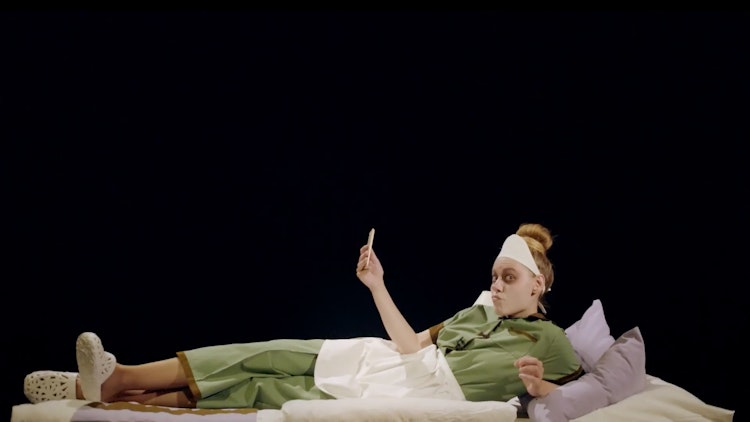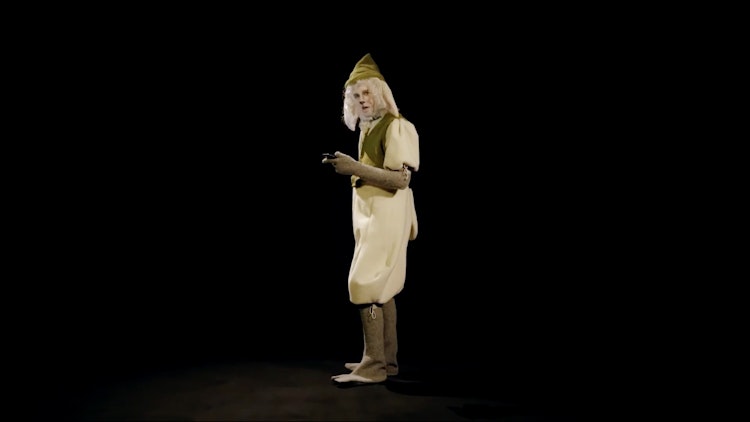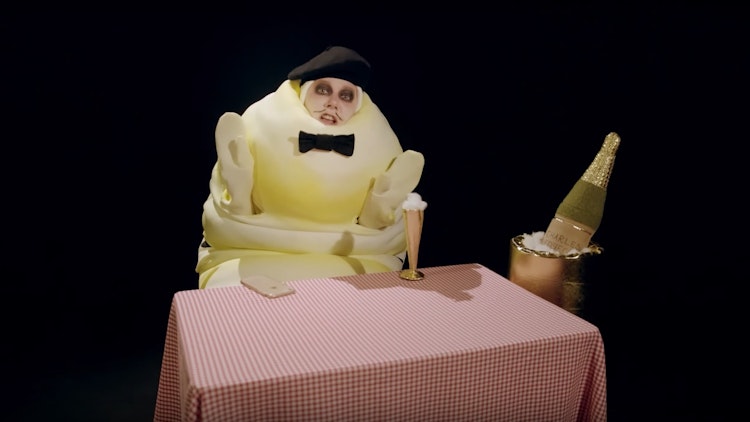Andreas Strand Renberg
Siri Hjorth and Sebastian Makonnen Kjølaas
Arlyne Moi
The artwork Pitch, Prosess, Produkt (2021) is a series of three short films by the artists Siri Hjorth and Sebastian Makonnen Kjølaas. Each film investigates contemporary textile art in a larger cultural context.
Pitch (13 min)
While working part-time as housekeepers at a half empty hotel, two artists share their half-baked ideas for a video work about textile art.
Prosess (8 min)
The textile artist Tove Ulla makes the most of her pastoral existence while conversing with a sentient lump of wool and a sheep with academic interests.
Produkt (13 min)
While sitting in a posh restaurant, a silkworm and titan of industry, who is in denial about his crumbling business, strikes up a conversation with an oyster eager to start a new luxury conglomerate.
"Following the logic of craft, Hjorth and Makonnen Kjølaas avoid any use of CGI, green screen or computer animation, choosing instead (rather hopelessly) to hold onto some semblance of being purely ‘material’ – at a time when art, social interactions and communication have been pushed even further into the digital sphere with the onset of the Covid-19 pandemic."
Siri Hjorth’s and Sebastian Makonnen Kjølaas’s Pitch, Prosess, Produkt examines both possible and impossible connections between textile art, industry, technology and commerce. Eclectic references are scattered throughout the three instalments.
In the first film, Pitch, one housekeeper/artist is inspired by Max Klinger’s famous work from 1878, Paraphrase über den Fund eines Handschuhs (Paraphrase on the Finding of a Glove), to make a script about an armless professor who invents a pair of flying nano-gloves. The armless professor is named after one of the world’s largest chemical producer, Dupont, founded in 1802, and the journalist in the script is named after Friedrich Engelhorn, the founder of the multinational chemical company BASF, founded in 1865. According to the housekeeper/artist, the story is meant to poke fun at art and new technology, capitalism and technocracy, and the idea that technology can replace human hands. Be that as it may, she mostly seems preoccupied with satirising the armless protagonist.
The second housekeeper/artist is clearly unimpressed by the pitch and afraid that it may not be politically correct (it obviously isn’t). However, his own pitch about an archaeologist inspired by the Greek story of Ariadne’s thread – which tries to tackle themes of misogyny and colonialism – is also highly problematic. The meta-story takes place in the frozen tundra and features an endless thread that the archaeologist happens to stumble upon. But the twist reveals that the archaeologist is actually an actor who is directed by a female director (what the ‘twist’ is supposed to contribute to the overall story is never disclosed). His intention of tackling misogyny is muddled by a terrible script as well as by his opening remark, which points out that he has been researching Marquis de Sade (specifically that de Sade’s family became rich by exporting and importing textiles). His reference to Ariadne in Greek mythology, perhaps the most canonised Western story imaginable, further erodes his credibility as a person addressing colonialism.
Both characters try to communicate their artistic ideas with an obvious lack of skill and self-reflection, and their remarks and reactions to each other’s pitches are mostly dishonest.
In the second episode, Prosess, the textile artist Tove Ulla (two common Norwegian names that in direct translation mean ‘fulling wool’) recounts a story from the Erotic Folktales collected by the Norwegian duo Asbjørnsen and Moe, both part of the 19th century National Romantic era, which inspires much of the episode’s aesthetics. Tove Ulla has great self-confidence, is crude and mocking toward her sheep, and dons a pair of textile tits.
Her sheep Lanolin reads e-flux and Texte zur Kunst news items (among them a press release from the show Reactivating Videographies, which ‘brings to the fore different working methods and formats in video art inside the current healthcare context’ no less). Lanolin also tries to talk about the philosophical and political concept of Localism, but his efforts are met with little enthusiasm.
The co-dependent lump of wool reminisces about the long tradition of fulling, a craft dating back to ancient Mesopotamia. Tove, deeply satisfied with being ‘in the process’, ends the episode by utilising the lump of wool, handling him and placing him on her head. It can be interpreted as a symbolic gesture that represents the process and material taking the place of theory and ideas in her (somewhat wayward) art and craft production.
In Produkt, a silkworm who runs a fashion and silk-production business enters a restaurant and obnoxiously demands immediate service. The waiter must listen to the silkworm’s ramblings about his business and philosophy of life. Among the references to luxury brands and his childhood beneath a mulberry tree (which is what silkworms eat), he also points out that he admires the Roman emperor Elagabalus (officially known as Antoninus), who’s unusual reign coincided with the introduction of silk apparel in the upper classes of the Roman Empire (google the guy!).
Emails ticking in on the silkworm’s phone show that his business is on the verge of collapse. He has exploited child labour, committed environmental crimes and is caught out as a tax evader. Presenting his life as a ‘rags to riches’ story, the silkworm goes on to discuss his future prospects with an optimistic oyster. The conversation descends into a dark fantasy of exploitative capitalism. The transactional relationship between man and nature is highlighted through their disturbing idea for a new luxury conglomerate based on merging silk and pearls in a perverse union. (Throughout the episode the silkworm and oyster quote the erotic tale The Golden Lotus by Lanling Xiaoxiao Sheng.)
Textiles play a dominant aesthetic role in Hjorth’s costumes and props. Set against a black backdrop within which the actors are placed, as if in a theatre setting reminiscent of the one used for Derek Jarman’s experimental comedy-drama Wittgenstein (1993).
Following the logic of craft, Hjorth and Makonnen Kjølaas avoid any use of CGI, green screen or computer animation, choosing instead (rather hopelessly) to hold onto some semblance of being purely ‘material’ – at a time when art, social interactions and communication have been pushed even further into the digital sphere with the onset of the Covid-19 pandemic.
The mobile phone, the only prominent non-textile object in the series, is ever present. It acts as a medium for creative output and escapism, a means for acquiring information, and an apparatus for communication, respectively.
Pitch, Prosess, Produkt is commissioned and produced by Norwegian Crafts and features music by Andreas Strand Renberg. The film series has received support from Arts Council Norway and the Norwegian Embassy in Paris.


